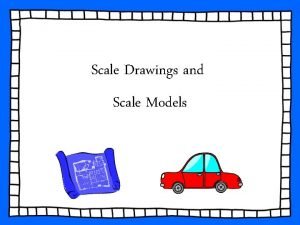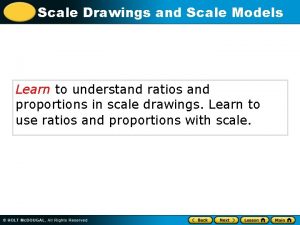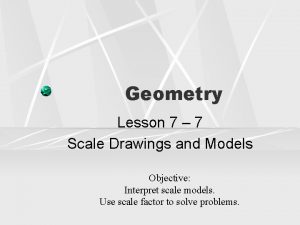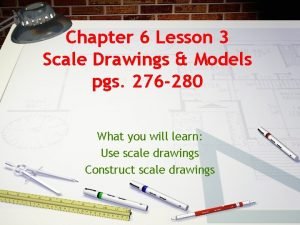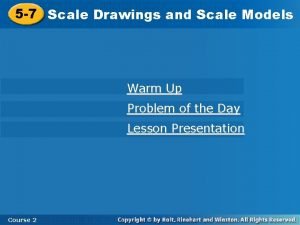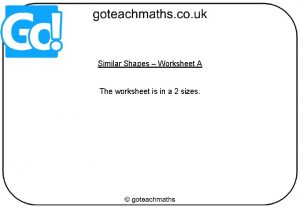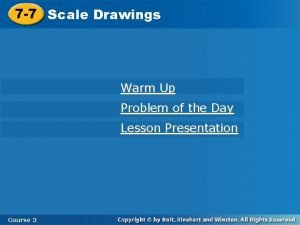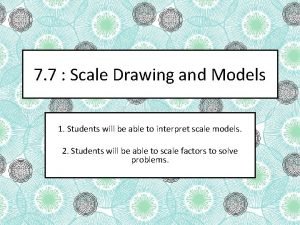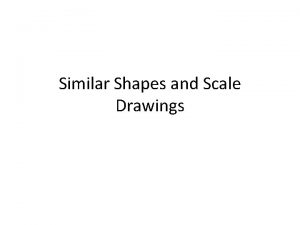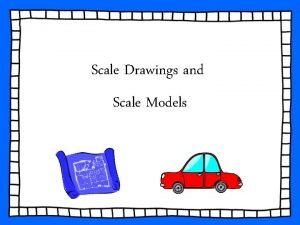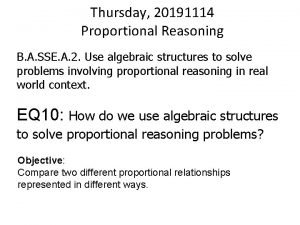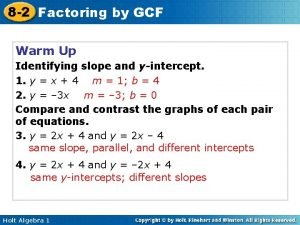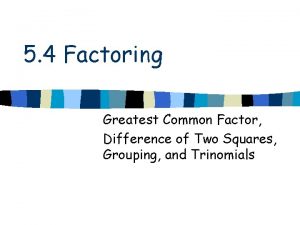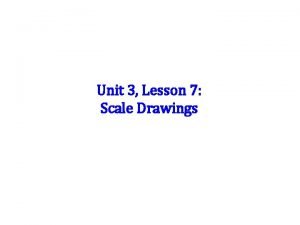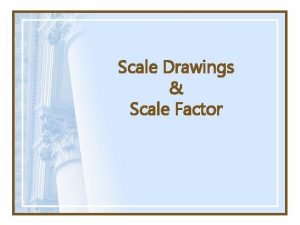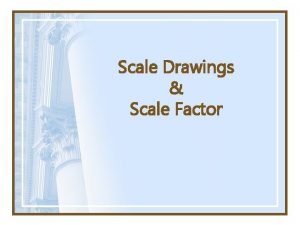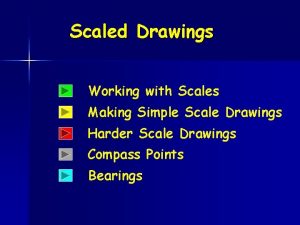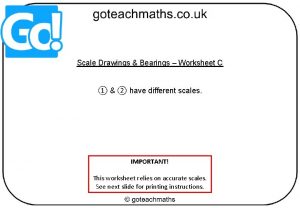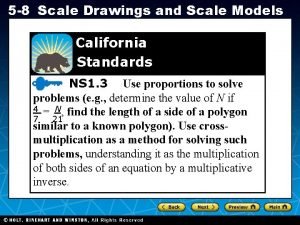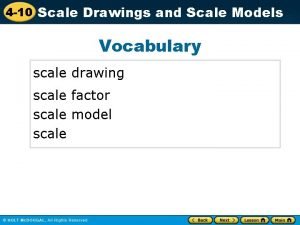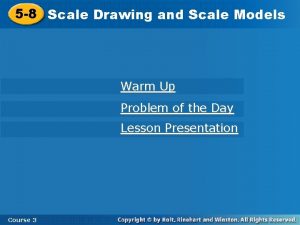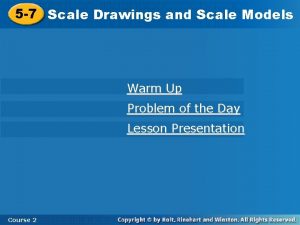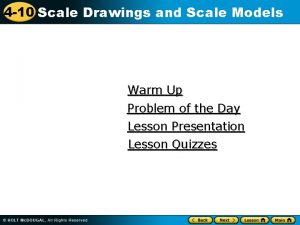Scale Drawings And Scale Factor Understanding Scales All

























- Slides: 25

Scale Drawings And Scale Factor

Understanding Scales All scale drawings must have a scale on them. Scales are usually expressed as a ratio. Normally, for buildings and models, the ratio is : Drawing Length : Actual Length For maps, the ratio is normally in the ratio: Map Distance : Actual Distance Scale : Actual Example A: 1 cm : 100 cm: The ratio 1 cm : 100 cm means that for every 1 cm on the scale drawing, the actual length will be 100 cm. Example B: 1: 10000: The ratio 1: 10000 means that the real distance is 10, 000 times the length of one unit on the map or drawing. Example C: 10 : 1 The ratio 10 : 1 means that the real distance is 1/10 the length of on the map or drawing. (Enlargement)

How to find “Scale Factor” • • When a figure is dilated (increased), its size is changed by multiplying the length of each side by a scale factor. All angles remain the same so the new shape (or image) is similar to the original. Can be found by dividing a new side length by the original side length. • When going from a small shape to a larger shape the scale factor is greater than 1. (Enlargement) • When going from a large shape to a smaller shape the scale factor is less than 1. (Reduction) 1. 2. 3. 4. Determine the corresponding side lengths. Determine if you are making a larger shape or a smaller shape. Determine if the scale factor is greater than or less than 1. Write the correct ratio.

Scale Factor = new measurement old measurement new Old Measurement x SF = New Measurement SF Enlargement Scale factor > 1 Reduction Scale factor < 1 Congruent shapes are similar shapes with SF = 1 old

Vocabulary scale model scale factor scale drawing

• The scale can be written as a scale factor, which is the ratio of the length or size of the drawing or model to the length of the corresponding side or part on the actual object. • Scale Factor needs to be the SAME UNITS!


A scale is the ratio between two sets of measurements. Scales can use the same units or different units. A scale drawing is a proportional drawing of an object. Both scale drawings and scale models can be smaller or larger than the objects they represent.

If you have seen Jurassic Park, you saw how big the dinosaurs were compared to the people. Pretend they made a large Human to watch over the animals. What would be the scale factor if a 64 inch person was made to be 160 feet?

The scale factor tells you how many times bigger than “normal” that person really is. You must make all units of measure the same…. 64 inches = 64 inches__ 160 feet 160 x 12 1920 inches

Now take the: 64 inches 1920 inches And simplify 1/30 inches This means that the “New” person was created 30 times the original (normal) normal size.

Scale • If the drawing is 6 inches long, what is the length of the pool?

Setting up Proportions (If the drawing is 6 inches long, what is the length of the pool? ) Keep “like units” in the same fraction. 1” : 20 yards. Distance in picture is 6” Inches = yards Inches yards 120 = y Keep “Ratio units” Model Scale = Actual Scale = ACTUAL = 120

Remember… • There is more than one way to set up a proportion correctly! • Cross Multiply! • Use common sense!

Write a Proportion Using Scales • Tom is drawing a blueprint for a rectangular shed he wants to build. • The scale is 1 ft. to ¼ inch. • If the dimensions of the blueprint are: 1 ¼ in. by 2 inches, What are the actual dimensions of the shed? 1. 25 /. 25 = 5 Feet

Write a Proportion Using a Scale ¾ inch to 1 foot • If the scale length is 2 ¼ inch, what would the actual length be in feet ?

Scale Drawings

What are scale drawings? Scale drawings are everywhere! Scale Drawings On Maps Vehicle design Footprints of houses

Scale in everyday life: kitchen design 6 cm Scale 1 cm = 1 m Length of units = 6 m 5

Scale in everyday life: plans decking pool path Scale: 2 cm = 1 m 7

Using A Scale Drawing

When objects are too small or too large to be drawn or constructed at actual size, people use a scale drawing or a model. The scale drawing of this tree is 1: 500 If the height of the tree on paper is 20 inches, what is the height of the tree in real life?

The scale is the relationship between the measurements of the drawing or model to the measurements of the object. In real-life, the length of this van has a measure 240 inches. However, the length of a copy or print paper you could use to draw this van is a little bit less than 12 inches.

Map Scales • Map Scales (Legends) are used to find distances on a map. • For example, if your map legend is ½” : 50 miles, how could you find the mileage for a 2 inch distance on the map? Seeing this ration is “easy” the Actual is 100 times the drawing scale Or Cross Multiply: . 5 A = 2(50) A = 100 /. 5 = 200 Miles

Map Scales Ratios and proportions can be used to find distances using a scale. Example: 1 inch = 15 miles The distance from Jacksonville to Smithtown on a map is 4 inches. How many miles are between these cities? 1 in. = 4 in 15 mi. n The distance M = 60 1 n = 60 between the two cities is 60 miles.
 7-7 scale drawings and models practice
7-7 scale drawings and models practice Understanding scale drawings
Understanding scale drawings 7-7 scale drawings and models
7-7 scale drawings and models Old scale drawing
Old scale drawing Understanding scale drawings
Understanding scale drawings 7-7 scale drawings and models answer key
7-7 scale drawings and models answer key 7-7 practice scale drawings and models
7-7 practice scale drawings and models 7-7 scale drawings and models worksheet answer key
7-7 scale drawings and models worksheet answer key Similar figure worksheet
Similar figure worksheet Drawings of models
Drawings of models Scale drawings worksheet
Scale drawings worksheet Scale factor warm up
Scale factor warm up 7-7 scale drawings and models
7-7 scale drawings and models Similar figures and scale drawings
Similar figures and scale drawings A proportional two-dimensional drawing of an object
A proportional two-dimensional drawing of an object Name three lines
Name three lines The diagram shows a tree and a man
The diagram shows a tree and a man Scale drawing worksheet
Scale drawing worksheet Practice proportional reasoning with scale drawings
Practice proportional reasoning with scale drawings Types of assembly drawing
Types of assembly drawing Lesson 4 scale drawings
Lesson 4 scale drawings Power of sine wave
Power of sine wave Factors of 18
Factors of 18 All learning is understanding relationships
All learning is understanding relationships Lesson 8-2 factoring by gcf
Lesson 8-2 factoring by gcf Factoring greatest common factor
Factoring greatest common factor
